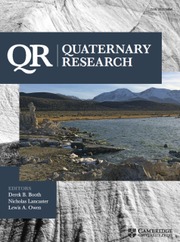No CrossRef data available.
Article contents
Disentangling local and regional factors for establishment of the magnetic paleoenvironmental proxy records derived from loess–paleosol sequence in Bulgaria
Published online by Cambridge University Press: 16 October 2025
Abstract
Magnetic susceptibility variations in loess–paleosol successions are widely utilized proxy records for reconstructions of global climate change during the Pleistocene. Analysis of the role of local factors in the establishment of magnetic signatures is rarely addressed. This study compares magnetic records along several adjacent profiles exposed in three open quarries near Kaolinovo (NE Bulgaria). The effect of the position of the sampled locations in the local landscape on the magnetic enhancement is revealed by differences in the thickness and degree of pedogenic magnetic enhancement. The profile, situated in a local paleo-depression, revealed disturbed sedimentation and depletion in the magnetic susceptibility. At lateral distances of 2–3 km (between quarries) the magnetic records show firmly repeatable patterns. Magnetic, geochemical, and diffuse reflectance data demonstrate a trend of increasing content of pedogenic hematites towards older paleosols, while goethite has major contribution to dithionite extractable iron phases. A representative stacked record of magnetic susceptibility for the Kaolinovo site is established using the results from mineralogical analyses. Comparison of the stacked susceptibility record from Kaolinovo with other sites from Bulgaria reveal that loess–paleosol sequences preserve reliable and repeatable magnetic records of global climate change for the last three glacial–interglacial cycles.
Keywords
Information
- Type
- Research Article
- Information
- Copyright
- © The Author(s), 2025. Published by Cambridge University Press on behalf of Quaternary Research Center.


